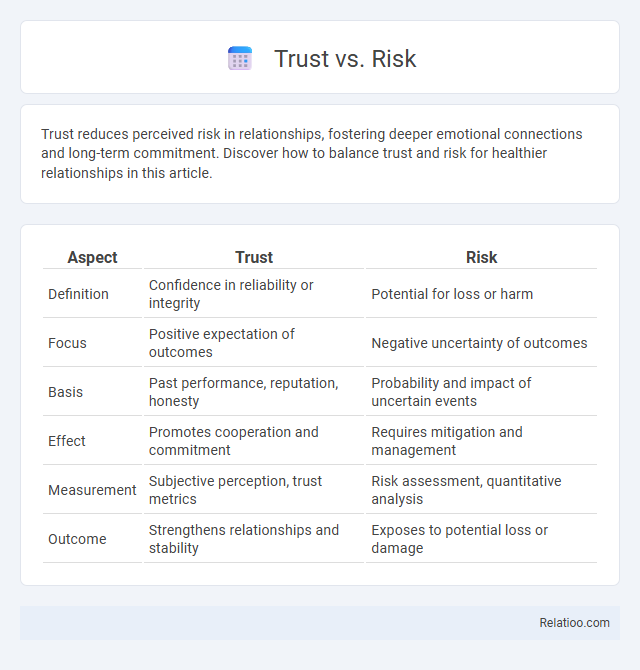Trust reduces perceived risk in relationships, fostering deeper emotional connections and long-term commitment. Discover how to balance trust and risk for healthier relationships in this article.
Table of Comparison
| Aspect | Trust | Risk |
|---|---|---|
| Definition | Confidence in reliability or integrity | Potential for loss or harm |
| Focus | Positive expectation of outcomes | Negative uncertainty of outcomes |
| Basis | Past performance, reputation, honesty | Probability and impact of uncertain events |
| Effect | Promotes cooperation and commitment | Requires mitigation and management |
| Measurement | Subjective perception, trust metrics | Risk assessment, quantitative analysis |
| Outcome | Strengthens relationships and stability | Exposes to potential loss or damage |
Understanding Trust and Risk: Core Definitions
Trust represents the confidence You place in a person's reliability and integrity, while risk involves the possibility of loss or negative outcomes in uncertain situations. Understanding trust requires evaluating past experiences, reputation, and consistency, whereas risk assessment focuses on identifying potential threats and their impact. Balancing trust and risk is essential for effective decision-making in both personal relationships and business environments.
The Interplay Between Trust and Risk
Trust and risk are intrinsically linked, shaping decisions in uncertain environments where outcomes are unpredictable. Your ability to evaluate the level of trustworthiness can mitigate perceived risks, influencing choices in personal relationships and business transactions. Understanding this interplay enhances risk management strategies, ensuring more informed and confident decision-making.
Psychological Foundations of Trust and Risk
Psychological foundations of trust involve cognitive assessments of others' reliability paired with emotional expectations of benevolence, shaping decisions in uncertain environments. Risk perception is influenced by individual differences in tolerance and affective responses, leading to varied reactions despite identical objective hazards. Understanding the dynamic interplay between trust and risk reveals how people manage uncertainty by balancing anticipated benefits against potential losses through mental heuristics and social experiences.
Trust-Building in High-Risk Scenarios
Trust-building in high-risk scenarios requires transparent communication, consistent actions, and demonstrated reliability to mitigate uncertainty. Establishing clear protocols and accountability encourages stakeholder confidence, reducing perceived risk. Leveraging past performance data and third-party validations further strengthens trust despite inherent risks.
Measuring Risk in Decision-Making Processes
Measuring risk in decision-making processes involves quantifying potential losses and probabilities of adverse outcomes to inform more reliable choices. Tools like risk matrices, probability distributions, and scenario analysis provide structured frameworks for assessing uncertainties. Your ability to balance trust in available data against identified risks ensures more effective and confident decisions.
Trust Erosion: Causes and Consequences
Trust erosion stems from repeated breaches, inconsistent communication, and unmet expectations, significantly undermining Your confidence in relationships or organizations. This decline in trust increases perceived risk, leading to hesitation and cautious behavior that can hinder collaboration and innovation. Identifying and addressing the root causes of trust erosion is crucial for mitigating its detrimental consequences on both personal and professional levels.
Strategies to Balance Trust and Manage Risk
Effective strategies to balance trust and manage risk involve establishing transparent communication channels and implementing robust verification processes. You can enhance trust by consistently delivering on commitments while employing thorough risk assessments to identify and mitigate potential threats. Combining proactive monitoring with contingency planning ensures a resilient framework that safeguards your interests without compromising collaborative relationships.
The Role of Communication in Trust and Risk Management
Effective communication is crucial in balancing trust and risk management, as transparent information exchange builds confidence and reduces uncertainty. Clear dialogue between stakeholders enables identification and mitigation of potential risks, fostering a collaborative environment for decision-making. Consistent and open communication channels strengthen trust, which in turn enhances organizational resilience and risk-taking capability.
Trust vs Risk in Business Partnerships
Trust in business partnerships fosters collaboration, reduces transaction costs, and enhances long-term value creation while risk involves uncertainty that can lead to financial loss or reputational damage. Effective management of trust mitigates perceived risks by encouraging transparency, reliability, and mutual accountability between partners. Your ability to balance trust with risk assessment directly influences the stability and success of strategic alliances.
Future Perspectives: Navigating Trust and Risk in a Digital World
Navigating trust and risk in a digital world requires you to balance cybersecurity measures with emerging technological advances like AI and blockchain, which reshape digital interactions and data privacy. Future perspectives emphasize adaptive strategies that prioritize transparency, decentralized verification, and real-time risk assessment to mitigate evolving threats. Building resilient digital ecosystems enhances trustworthiness while enabling innovation-driven growth amid uncertain risk landscapes.

Infographic: Trust vs Risk
 relatioo.com
relatioo.com